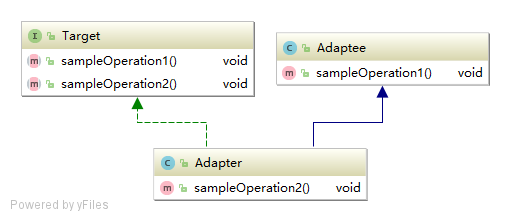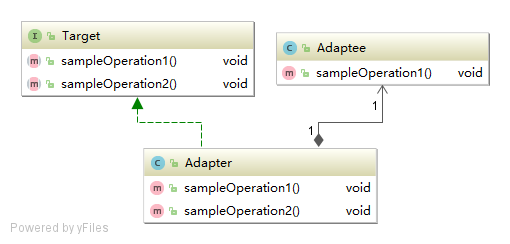Java 设计模式系列(六)适配器模式
适配器模式把一个类的接口变换成客户端所期待的另一种接口,从而使原本因接口不匹配而无法在一起工作的两个类能够在一起工作。
适配器模式的结构:
- 类的适配器模式
- 对象的适配器模式
一、类适配器模式
类的适配器模式把适配的类的 API 转换成为目标类的 API。

在上图中可以看出,Adaptee 类并没有 sampleOperation2() 方法,而客户端则期待这个方法。为使客户端能够使用 Adaptee 类,提供一个中间环节,即类 Adapter,把 Adaptee 的 API 与 Target 类的 API 衔接起来。Adapter 与 Adaptee 是继承关系,这决定了这个适配器模式是类的:
模式所涉及的角色有:
(1)目标(Target)角色:这就是所期待得到的接口。注意:由于这里讨论的是类适配器模式,因此目标不可以是类。
(2)源(Adapee)角色:现在需要适配的接口。
(3)适配器(Adaper)角色:适配器类是本模式的核心。适配器把源接口转换成目标接口。显然,这一角色不可以是接口,而必须是具体类。
源代码
public interface Target {
/** 这是源类Adaptee也有的方法 */
public void sampleOperation1();
/** 这是源类Adapteee没有的方法 */
public void sampleOperation2();
}
上面给出的是目标角色的源代码,这个角色是以一个 JAVA 接口的形式实现的。可以看出,这个接口声明了两个方法:sampleOperation1() 和 sampleOperation2() 。而源角色 Adaptee 是一个具体类,它有一个 sampleOperation1() 方法,但是没有 sampleOperation2() 方法。
public class Adaptee {
public void sampleOperation1(){}
}
适配器角色Adapter扩展了Adaptee,同时又实现了目标(Target)接口。由于Adaptee没有提供sampleOperation2()方法,而目标接口又要求这个方法,因此适配器角色Adapter实现了这个方法。
public class Adapter extends Adaptee implements Target {
/**
* 由于源类 Adaptee 没有方法 sampleOperation2()
* 因此适配器补充上这个方法
*/
@Override
public void sampleOperation2() {
//写相关的代码
}
}
二、对象的适配器模式
与类的适配器模式一样,对象的适配器模式把被适配的类的 API 转换成为目标类的 API,与类的适配器模式不同的是,对象的适配器模式不是使用继承关系连接到 Adaptee 类,而是使用委派关系连接到 Adaptee 类。

public interface Target {
/** 这是源类Adaptee也有的方法 */
public void sampleOperation1();
/** 这是源类Adapteee没有的方法 */
public void sampleOperation2();
}
public class Adaptee {
public void sampleOperation1(){}
}
public class Adapter implements Target {
private Adaptee adaptee;
public Adapter(Adaptee adaptee){
this.adaptee = adaptee;
}
/** 源类 Adaptee 有方法 sampleOperation1,因此适配器类直接委派即可 */
public void sampleOperation1(){
this.adaptee.sampleOperation1();
}
/** 源类 Adaptee 没有方法 sampleOperation2,因此由适配器类需要补充此方法 */
public void sampleOperation2(){
//写相关的代码
}
}
建议尽量使用对象适配器的实现方式,多用合成/聚合、少用继承。
三、缺省适配模式的结构
缺省适配模式是一种“平庸”化的适配器模式。
public interface AbstractService {
public void serviceOperation1();
public int serviceOperation2();
public String serviceOperation3();
}
public class ServiceAdapter implements AbstractService{
@Override
public void serviceOperation1() {
}
@Override
public int serviceOperation2() {
return 0;
}
@Override
public String serviceOperation3() {
return null;
}
}
可以看到,接口 AbstractService 要求定义三个方法,分别是 serviceOperation1()、serviceOperation2()、serviceOperation3();而抽象适配器类 ServiceAdapter 则为这三种方法都提供了平庸的实现。因此,任何继承自抽象类 ServiceAdapter 的具体类都可以选择它所需要的方法实现,而不必理会其他的不需要的方法。
适配器模式的用意是要改变源的接口,以便于目标接口相容。缺省适配的用意稍有不同,它是为了方便建立一个不平庸的适配器类而提供的一种平庸实现。
在任何时候,如果不准备实现一个接口的所有方法时,就可以使用“缺省适配模式”制造一个抽象类,给出所有方法的平庸的具体实现。这样,从这个抽象类再继承下去的子类就不必实现所有的方法了。
适配器模式的优缺点
适配器模式的优点
-
更好的复用性
系统需要使用现有的类,而此类的接口不符合系统的需要。那么通过适配器模式就可以让这些功能得到更好的复用。 -
更好的扩展性
在实现适配器功能的时候,可以调用自己开发的功能,从而自然地扩展系统的功能。
适配器模式的缺点
过多的使用适配器,会让系统非常零乱,不易整体进行把握。比如,明明看到调用的是 A 接口,其实内部被适配成了 B 接口的实现,一个系统如果太多出现这种情况,无异于一场灾难。因此如果不是很有必要,可以不使用适配器,而是直接对系统进行重构。
每天用心记录一点点。内容也许不重要,但习惯很重要!